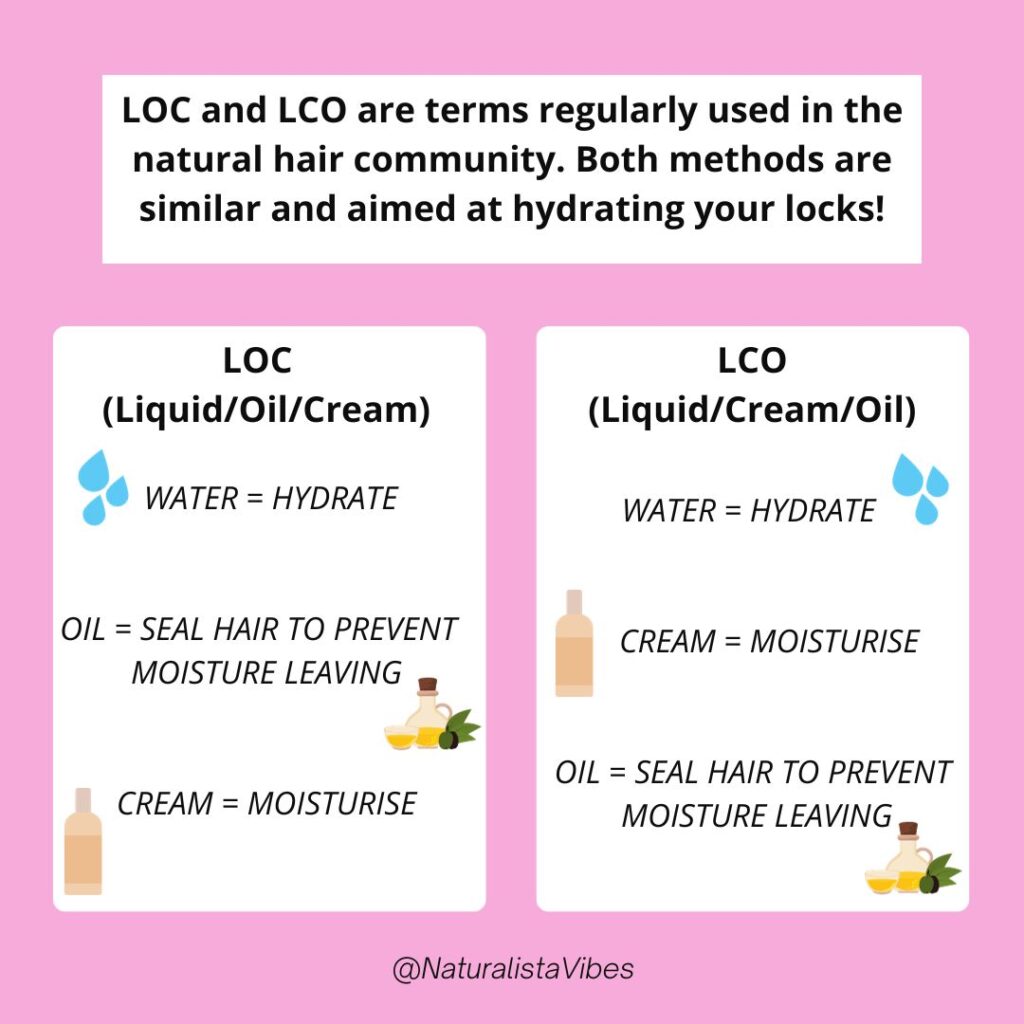This post may contain affiliate links and we may get paid a small commission if you click on a link. Please read our privacy policy and cookies disclosure.
Getting moisture into your hair strands is a key component for maintaining healthy natural hair. It’s no surprise Type 4 Hair is prone to dryness and you’ll need to adopt moisture retention techniques into your natural hair regimen. You’ll also need to pay close attention to the ends of your hair which is likely to be dull, brittle and break easily due to wear and tear. The LOC & LCO methods are a way of getting that much needed moisture back into your hair strands whilst locking it in.
You’ve probably heard of the LOC or LCO method at some point during your natural hair journey but may not be 100% sure on what method is best for you. Both methods utilise the same products which can cause some confusion. The main difference between the two methods is the layering and application process of your hair products.
So which one is better for your hair? In this article we’ll cover everything you need to know re; the LOC VS LCO method to help you decide what method to incorporate into your hair regimen. The good news is you can use either method but one method might favour your hair more depending on your hair density, type and porosity.
What is the LOC & LCO Method?
LOC stands for liquid first, oil second and cream last. Whilst LCO stands for liquid first, cream second and oil last. Both methods use the same components starting with liquid. But the main difference is the second and third step swap places. The methods are known for hydrating your hair whilst ensuring the moisture has fully penetrated through to your hair shaft by sealing it with a cream and oil.
Let’s delve into the definitions in a bit more detail to give you a better understanding of how they work together.
LIQUID
This is the first step in the LCO & LCO method. You can use a liquid or leave-in conditioner but make sure the product you choose is water based. Reason being, is you want your hair to be fully hydrated and ensure an adequate amount of moisture has entered into the strands before following up with the next steps. Moisture is every naturals friend and without it your hair will become dry and brittle leading to excessive breakage. If you’re struggling to find a liquid based leave in conditioner then feel free to just use water! Water is an easy way to hydrate your hair and acts as a moisturising agent.
OIL
This is the second step in the LOC method & third step in the LCO method. The oil acts as a sealing agent to lock the moisture into your hair strands and prevent it from leaving. In simple terms, it helps keep your hair moisturised for longer. Depending on your hair porosity – you’ll need to be careful with what oils you use as some can be heavier than others. We’ll cover this in a bit more detail in the section below to help you decide what type of oils to use.
CREAM
This is the third step in the LOC method and second step in the LCO method. In most cases the cream is a water based product which also contains oils and butters. Although the cream can act as a sealing agent due to the oils & butters in the mixture. It also has hydrating benefits which adds that extra nourishment to your strands. It tends to be thicker and denser in consistency in comparison to other products you’ll be using to hydrate your strands.

How Hair Porosity Can Impact the Method you Choose?
Both the LOC and LCO method are great ways of increasing moisture retention. Although, both have similarities – it’s best to choose a method that aligns to your hair needs and goals to reap the full benefits. Luckily, either method works well with Type 4 hair regardless of if you’re a Type 4A, B OR C Naturalista. But hair porosity has a significant part to play when choosing a method to adopt into your hair regimen.
Porosity is an indicator of how easily moisture can penetrate through your hair shaft. You’ll either have high, normal or low hair porosity. As a rule of thumb, the LOC method is typically best for high to medium porosity hair whilst the LCO method is best for low to medium porosity hair. Here’s WHY?
HIGH POROSITY
High porosity hair tends to have difficulty retaining moisture due its loose cuticles. This makes it easy for moisture to penetrate through the hair shaft but also makes it very easy for moisture to leave. This makes it difficult and challenging for Naturals with high porosity hair to retain moisture. Using the LOC method will help moisture stay in your hair shaft for longer. The oil acts as a sealant to keep the moisture from evaporating whilst the cream seals and locks in the moisture for added protection.
LOW POROSITY
Low porosity hair on the other hand has difficulty absorbing moisture due to its tight cuticles. Water tends to sit on the hair strands as opposed to penetrating through the hair shaft. The good thing is that once your hair is fully hydrated – the moisture tends to stay in and doesn’t easily evaporate. The cream helps add that extra hydration and moisture into the shafts whilst the oil acts as a sealant to lock it all in.
MEDIUM POROSITY
Medium porosity hair is a mix of both worlds as its cuticles are looser than low porosity but tighter than high porosity. This makes it easy for moisture to penetrate through the hair shaft but also means it stays in for a good period of time. With normal porosity – you can use either the LOC or LCO method depending on your preference.


5 TIPs for getting the optimum moisture into your Hair Shaft
- Start off with freshly washed hair using a moisturising shampoo. If you notice you have product build up then use a clarifying shampoo to ensure your hair is fully clean
- Follow up with a deep conditioning treatment. Using heat will help the product penetrate through your hair strands so you can reap the full benefits of the treatment.
- Detangle your hair thoroughly to minimise any tangles or knots
- Follow up with the LCO or LOC method – ensure your hair is damp prior to layering products
- Sleep with a silk or satin bonnet or pillowcase. Silk is known for helping keep moisture in compared to cotton which can be drying.
Understanding Oils
With so many oils on the market, you’re probably wondering what oil is best to pick. High and Low porosity hair have different needs which means you have to be selective with what oil you choose to use. As high porosity hair loses moisture easily, you’ll need to pick a heavier oil to help seal in the moisture. Low porosity hair on the other has a harder time penetrating products so its best to use a lightweight oil to minimise build up.
Examples of heavy oils : Olive oil, Castor oil, Coconut oil
Example of lightweight oils : Argan oil, Avocado oil, Jojoba oil

FAQ’s re; LOC & LCO Method
1: Can I do the LOC OR LCO method everyday?
It’s not advised to use the LOC or LCO method daily to minimise product build up. The purpose of the LOC and LCO method is to retain moisture in your hair strands which takes away the burden of doing it daily. Ideally, you want to be doing this method on wash days when your hair is thoroughly cleansed. It’s likely you’ll need to refresh your hair in between wash days to keep your hair moisturised. If this is the case then you can co-wash your hair or spritz your hair with water and follow through with the method of choice.
If you do opt for doing the method daily, you’ll need to use lightweight products and pay attention to build up. You may need to wash your hair more regularly i.e. every week as opposed to bi-weekly and incorporate a clarifying shampoo into your routine at least once a month.
2: How often should I do the LOC OR LCO method?
Ideally, you want to be doing this method on wash days and then follow up with a refresh every 4 – 7 days. Now this will vary depending on your hair needs and styling preferences. For instance, if you’re rocking a wash n go – it’s likely you’ll need to refresh your hair more often as your hair is out compared to if you’re rocking a bun and your hair is tucked away.
If you’re new to the method then you might want to start doing it once a week and do a refresh mid-week. From there, you can measure how your hair responds and decide if you need to do it more or less regularly.
3: How long does the LOC OR LCO method last?
It lasts anything from 3 to 7 days.
4: Do you put curl cream or leave in conditioner first?
Always apply your leave in conditioner first. Leave-in conditioners are designed to add moisture back into your hair shaft after washing. It also strengthens and protects your hair to make daily styling easier. Curl creams on the other hand enhances your curl pattern to define your curls, smooth away frizziness and give your hair that extra shine. Just be mindful with how much product you apply daily to minimise product build up. Overuse of product can cause your hair to become lacklustre and brittle leading to breakage.
Final Thoughts
Regardless of what method you choose. All steps work hand in hand for moisture retention and keeping your hair hydrated for longer. We hope whatever method you choose, it helps with your hair goals of achieving healthy kinks, coils and curls. Pick one that works for you and if you feel you’re not getting the best results try the other method. This will help you identify if the LOC or LCO method works best. Another key factor to be aware of is being mindful of what products you choose to incorporate. Read the ingredients of the products to ensure they have hydrating benefits to keep your hair from drying out.
Have you tried the LOC or LCO method? Which one do your prefer and why?











